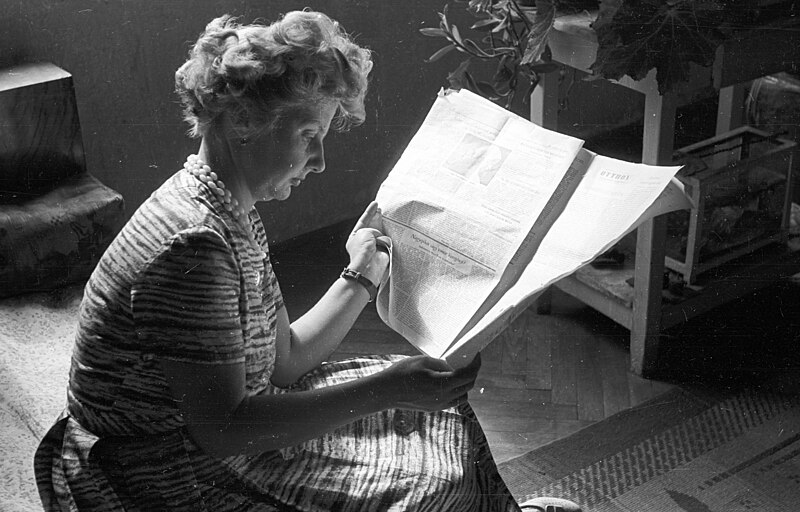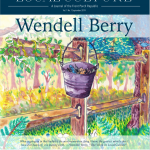County Highway offers a more tactile experience than most contemporary media. It’s a magazine printed as a newspaper. It opens wide. It invites folding. People will notice when you are carrying it. The print smudges onto your fingers just a bit. It reminds of you of another era, when you used to read the newspaper, on paper. It’s impossible to scroll. It’s no wonder that County Highway has captivated many readers and become a phenomenon.
If you haven’t heard of County Highway, it’s a new periodical. It only appears in print. It comes out six times per year. According to the magazine, it “is a 20-page broadsheet produced by actual human beings, containing the best new writing you will encounter about America. It features reports on the political and spiritual crises that are gripping our country and their deeper cultural and historical sources; regular columns about agriculture, civil liberties, animals, herbal medicine, and living off the grid, mentally and physically; essays about literature and art, and an entire section devoted to music.” It comes to you in the mail. (I’m a new subscriber and the following observations are based on Vol.1, Issue 2, September-October 2023.)
According to the editors, County Highway wants to be the obverse of that notorious New Yorker’s view of the world map. Editor-at-Large, Walter Kirn, has said “we’re going to make the small towns of America into New York City.” The periphery should be the center. And, in some ways, that is upheld. There is no section about the arts in New York. The opening pages include a grain report and an agricultural digest. The editor’s note is called “The Front Porch.” The second issue included a beautiful firsthand piece on logging by Troy Sweeney.
The articles are interesting. Vol.1, Issue 2 included an interview with the “UFO Whistleblower Dave Grusch.” We learned that the Hell’s Angels have gone soft (perhaps that was just reaffirmed). The issue also includes a piece on mules, an article about natural remedies, and a squirrel recipe. There is a general farmer’s-almanac-feel to the magazine. CH includes “America by the numbers”—with some statistics, and an “American Glossary”—written in the style of Ambrose Bierce. That second issue also included a poetry corner with a poem called “Crop” by Samuel Dickison.
Yet County Highway is not county-specific. It’s for all of America outside major cities. Well, outside of New York and Los Angeles, for sure. In the second issue, there’s a piece about unions in Las Vegas. Another “outsider” voice comes from Miami, though he travels to Puerto Rico. It’s “the rest of America,” but it’s not necessarily rural America, despite the squirrel recipe. There’s Taylor Swift and pro wrestling rather than who was seen at Bemelmans Bar, but you’re not going to come away enlightened about Iowa or Nebraska, or anywhere in particular.
Despite the lack of precise location, County Highway deals with place. Perhaps the best piece in the second issue was the most philosophical–“GPS” by Will Self. That essay, labeled a “jeremiad,” explores our relationship to space and place in our current age. Self went beyond the usual critiques of GPS as limiting our navigational abilities, to the ways in which we have completely inaccurate perceptions of space because of the dominant modes by which we experience them. In his case, living in the UK, people wrongly assume it is nearly all developed and urbanized when the reality is the opposite. As Self puts it, “there is plenty of room in the Britain Isles—although not that much space.” The room is in space that is invisible to most people.
Self also writes compellingly about how our allegedly free movement, our travel, and all the personal time that we think distinguish us from earlier centuries, is not what we think it is. Self writes that “for the most part we are the prisoners of a metric that inexorably calibrates the time we take to travel a certain distance, against the money it costs. Yes: We’re all taxi drivers and our bodies are our vehicles—or Uber ones, more precisely, for this lifelong go-round we’re self-employed and lack any in-work benefits. Even our leisure travel—whether it’s some world-girdling vacation trip, or a stroll round the block—is subject to the same calculation not of liberty, but confinement.” Considering that in October 2023, Twitter was briefly abuzz about the accusation that hiking might be nothing more than “bourgeois consumption” with “alienated nature,” something indigenous people wouldn’t do—a little re-examination of how we experience the world and our awareness of our environment seems like a needed conversation.
As much as County Highway seems to come from the outside, its authors are primarily not outsiders. The editor, David Samuels, has worked for or with The New York Times Magazine, Harper’s Magazine, The Atlantic, N+1, The New Yorker, Tablet, and, in his college days, the Harvard Lampoon. Editor-at-large Walter Kirn lives in Montana, but you may have heard of one of his books, Up in the Air, which became that George Clooney movie. He has other books and he hosts a podcast with Matt Tabibi. The contributors are nearly all known, if not fully established, writers, with Iowa MFAs and experience at many big-name publications. People who actually eat squirrel without thinking much about it one way or the other probably don’t write for County Highway. I suspect—though I could be wrong—that most contributors probably don’t even garden.
The most interesting thing about County Highway is the age it evokes. The look is nineteenth century, but that is not the age that County Highway celebrates. Rather, everything about it feels late 20th century. From the first page, you get the sense that many of the authors have long adored Hunter S. Thompson. From the Hell’s Angels and UFOs to the way Taylor Swift is covered—it is abundantly clear the authors want to return to a golden age of literary non-fiction, with Joan Didion and Tom Wolfe. County Highway is full of stories with writers included in the narrative. The younger authors probably watched Almost Famous enough to know parts of it by heart.
You can imagine the brainstorming for County Highway: “Remember when Rolling Stone was cool?” “Remember when you could say whatever you want, like the early days of National Lampoon magazine?” County Highway is, like Thompson, a bit transgressive. And so the mood is not just that mules are interesting and that grain matters, but that Bill and Hillary should be mocked (take that, coastal elites), and also that Taylor Swift is “neither a brilliant singer nor a gifted dancer” though she can write “memorable lines and couplets” (take that, mainstream normies). You can’t trust the CIA and you should be able to shoot guns, and you should be able to enjoy the White Trash Cookbook without the PC police bugging you, but people really should unionize and please don’t send your kids to conservative schools. Jonah Raskin opens his piece assuring us that “if you were alive and paying attention to the world in the late 1960s and early 1970s, as I was, you would have loved Abbie Hoffman.” The project is a little bit renegade.
County Highway is an interesting piece of print. On the surface, it seems nostalgic for an earlier, agricultural era. But it’s actually nostalgic for a particular, not that distant, literary era. In an age of substacks and scrollable sites, it’s fun to sit and smudge some pages with your fingers a few times a year. According to Walter Kirn, “we want you to sit with this newspaper and a cup of coffee. There’s no algorithm in ‘County Highway.’ It takes a bit of concentration to read. It rewards a solitary experience. Maybe you can sit by yourself for 20 minutes in the morning and not be bombarded by headlines and what’s being pushed at you.” County Highway is not necessarily for all people outside New York City, but it’s certainly for writers who see themselves as outsiders and/or readers who are looking for something beyond the usual digital fare.
Image credit: via Wikimedia Commons







8 comments
Rob G
Thanks, Brian — will have to see if any of my local bookstores carry it.
Dutch
That aspect is appealing, Brian, and I like the way you describe it. It turns out a small bookstore in my hometown carries physical copies, and I’ll be there over Thanksgiving weekend so I’m planning to pick up a copy.
Brian D Miller
For what it is worth, I received a complimentary copy of the first issue and immediately subscribed. The writing can be a bit mixed and is not necessarily FPR in the content and message. But I have found the two issues (to date) engaging. And I like the way a physical publication migrates around our house. First, at my reading chair. Then it shows up in the bathroom, and later found by Cindy’s side of the bed. Eventually, some months down the road, I’ll find it again and read the long piece bout Taylor Swift or Puerto Rican wrestling.
Dutch
You’re probably right, Rob. Anything along these lines is bound to feel a little precious–and quixotic. In this age when we’re all more or less resigned to getting our news and magazine-type content online, it’s hard to see a print-only product as much more than a novelty whose appeal isn’t likely to last more than a year or two. It reminds me a bit of Pushcart Press publisher Bill Henderson’s “Lead Pencil Club” of the mid-1990s, his attempt to “pull the plug on the electronic revolution.” I admired the stance, but almost no one in the publishing world was going to be able to shun computers and have any hope of maintaining a career.
All that said, County Highway looks like it could be a fun read, but, like you, I’d need to see a copy before I spring for yet another subscription.
Martin
Or Spit in the Ocean published irregularly by Ken Kesey for a few years?
Dutch
This idea has a certain appeal, but overall it seems too precious by about half. I do miss good longform nonfiction (and the market for it), and I cut my teeth on great writing in which the author often appears–from Tom Wolfe to Ian Frazier and John McPhee–so that aspect doesn’t bother me, as long as they’re not mugging for the camera too much. But this attempt sounds like something cooked up by coastal types who are imagining what slightly benighted Middle America might be willing to pay $50/year for. But I’m often too cynical for my own good. I’d like to see a copy, but from their site it looks like the nearest one is a two-hour drive from my home.
Rob G
I feel somewhat the same way, although I have to wonder — wouldn’t almost anything that appeared nowadays that looked like this seem a bit precious?
I’m in the same boat however — would like to see a copy before I subscribed. I get more than enough periodicals already, and don’t want to add another one if it’s not going to be worthwhile.
Martin
Great overview, thanks. I’m always wary of stories that include a writer. I wonder if that’s a technique taught in writing workshops “How to overcome writer’s block”.
Comments are closed.